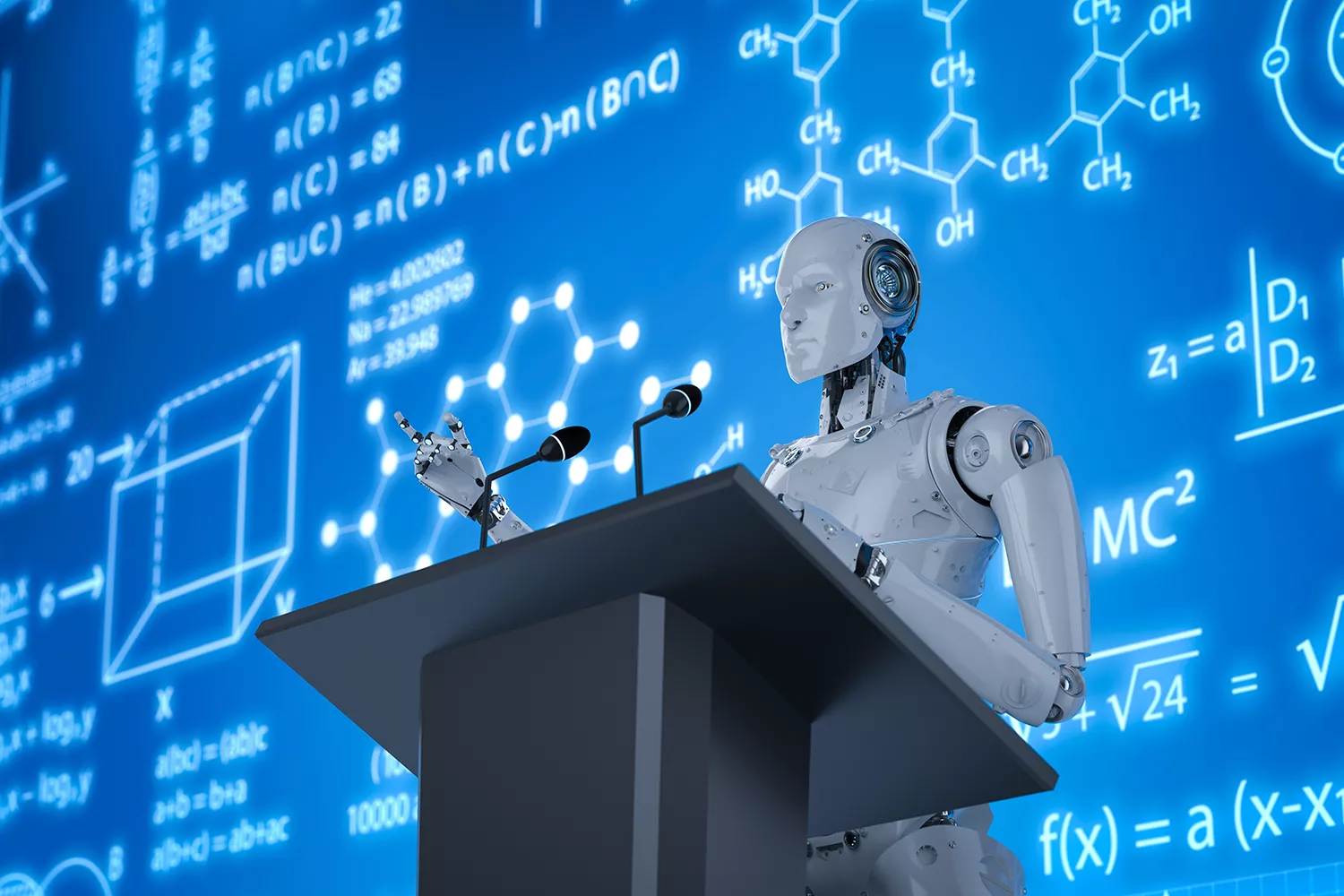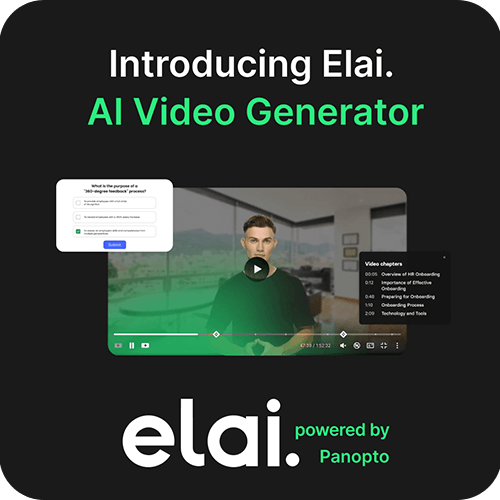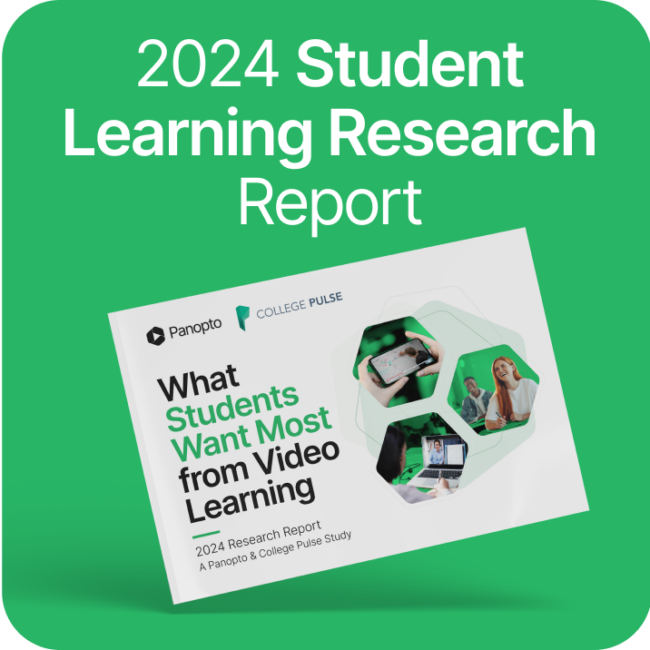- Education
5 Ways AI Will Impact Higher Education in 2023 and Beyond

When Associate Professor Jack Wang, a teaching-focused microbiologist based at the University of Queensland, first encountered the AI-powered chatbot ChatGPT, he was not only impressed – he was also concerned. Was he witnessing a future where he would be replaced as a teacher by AI?
In response, he created the video “Can AI replace professors?” and asked ChatGPT a range of questions to determine if it would be possible to successfully replace teachers. “Making that video was an interesting experience, as I had to challenge all of my preconceived notions about what my value as a teacher actually is,” Wang, who was named Australian University Teacher of the Year in 2020, told Panopto.
Released on November 30, 2022 by OpenAI, ChatGPT broke the internet, amassing over a million users in only five days. Two weeks after its release it was struggling to keep up with demand; it had become so popular that it had reached user capacity. Not surprising, considering what it is offering. ChatGPT isn’t the first AI-powered writing tool to be released to the education community. It is, however, the first to reach a human-like conversational and writing level. And that’s not all it can do – writing code, creating websites, and writing music are all in its repertoire.
The market for AI in education is anticipated to reach $80 billion worldwide by 2030. It has the potential to revolutionize the way we teach and learn, improving accessibility and equity in education for learners around the world. With such an anticipated rise, it’s crucial to question the impact AI will have on both the education system, and educators. Like all evolving technologies there are going to be flaws, and how we respond is what really matters.
Take the pressure of menial tasks off faculty and staff
It’s no secret that teachers are under-resourced and over-worked. An issue that was brought to light by the COVID-19 pandemic, a 2022 report found that 75% of teachers experience constant job-related stress while 59% are burned out. Burnout leads teachers to leave their jobs, which has since resulted in a national shortage of teachers following the pandemic – a shortage of 2.6 million educators who have resigned, to be exact.
If being under-resourced and over-worked is the issue, automating menial tasks is a potential answer. AI can be utilized to automate various aspects of education, such as data entry and paper-based grading, freeing up teachers to focus on more important tasks. According to McKinsey Global Institute’s 2018 report on the future of work, 20-40% of hours spent by teachers on activities could be automated using existing technologies. Panopto’s smart search enables teachers to save time that would otherwise be spent on transcribing, tagging, and categorizing all their video content. With the AI-powered technology, automatic speech recognition (ASR) captures and indexes every spoken word, while optical character recognition (OSR) indexes every word that visually appears on screen.
“AI will throw a spanner in the works (to put it mildly) for assessment design and academic integrity, but it can be a great way to brainstorm ideas for all the other domains of teaching activity that take just as much time to develop,” says Wang. Witnessing this idea in practice, AI-powered grading tool Gradescope reported a 30-60% reduction in time spent by teachers on grading assignments.
Meanwhile, Wildfire – self-proclaimed as the world’s first AI content-creation service – uses AI to create same-day content from videos, PowerPoint files, or documents. “You can send me a video, we strip the transcript, we apply AI techniques, and we produce a course the same day and send it back to you as a SCORM file, [then] you can put it on your LMS,” said Wildfire founder Professor Donald Clark at the Panopto 2022 EMEA User Conference.
Clark says that the program also helps increase retention thanks to its open input format. “Open input requires recall. You have to know it and that act of recall increases retention. AI can also semantically interpret open answers.” Clark told Panopto.
Improve accessibility in the classroom
Every student learns differently, and teachers often struggle to keep up with the needs of a diverse range of students. AI has the potential to create a custom-tailored educational experience, personalizing learning through discovering knowledge gaps, providing quick responses, and increasing accessibility for all students. In fact, it’s predicted that by 2026, RPA (robotic process automation) and AI will improve the student experience.
Tools such as Panopto’s smart search streamline tedious processes, allowing students to search the content of videos for any word that is spoken or shown, while automatic speech recognition (ASR) captions utilize AI to automatically add captions to Panopto videos. Another feature that has transformed the online learning space is “nudge learning.” “Look at Duolingo, it uses sophisticated spaced practice and notifications patterns, based on AI. We have looked at this in detail and it does something fascinating, based on forgetting, not remembering. This is the way to go in online learning,” says Clark, who is also the author of “Artificial Intelligence for Learning.”
Help personalize the student experience
AI tutors are being used increasingly to provide personalized educational instruction to students. By providing a variety of interactive tools and resources to uncover knowledge gaps, AI tutors can adapt to a student’s individual learning style and pace, ultimately increasing engagement. It’s been shown that students who used an online AI tutor had 2 to 2.5 times higher learning outcomes than those without an AI Tutor.
There’s also potential future benefits for students in scientific fields, where reports that include peer-reviewed sources and evidence-based citations are valued. “If chat GPT or other AI platforms could show their working, be more transparent when it comes to the source of their compiled responses, it could provide students with a great starting point for discovering more about a topic,” says Wang. “At the moment however, it remains a black box.”
Introduce new challenges around cheating
As beneficial as AI can be, there is the issue of cheating. What happens when students turn to AI-powered tools such as ChatGPT to write essays and conduct instant research? Running an essay written by ChatGPT leaves no evidence of plagiarism when run through a plagiarism checker.
“Complacency is never a good thing, and I think it will catch a lot of individual teachers off guard how capable generative AI is at responding to higher-order problems. Ultimately, this will put the quality of our assessment design to the test,” says Wang.
At this stage, it’s close to impossible to monitor if a student has used ChatGPT to write an essay. So, what are some potential solutions? Enforcing audio and video assessment that come directly from the student’s mouth. Video solutions such as Panopto could be used for social learning in the classroom and for recording video assignments to ensure students are displaying the skills being taught. This will encourage students to develop deeper-level thinking skills that require an understanding of the content being taught, and teachers to re-evaluate the way in which students are being assessed.
“Are we actually assessing for the learning objectives and graduate attributes that we say we are? Or are students (and in turn any AI tools that they have access to) being rewarded for surface-level information retrieval and memorization?” asks Wang.
Redefine accuracy in the educational experience
A study by the University of Murcia in Spain revealed that an AI chatbot was able to correctly answer student questions 91% of the time. That may seem impressive, but what about the other 9%?
Since ChatGPT was trained on information up until 2021, its knowledge may sometimes present inaccuracies and its answers may not always be up-to-date. It does not search the internet, so asking it to write an essay on an event that happened in 2022 may be useless given the limitations of its knowledge.
There may be benefits to the lack of accuracy that certain AI tools such as chatbots have. Students will be encouraged not to purely rely on AI to complete assessments, and will get in the habit of conducting deeper research to confirm the information they are given is correct.
In addition, what if students are able to analyze the inaccuracies and gaps shared by AI tools on certain topics to have their knowledge tested? This will involve deep-diving into a topic where students are pushed to compare a range of sources to develop complex analytical skills. They can then come up with suggestions for improvements on the AI chatbot’s information and offer their own hypothesis on varying topics.
“I want to show students worked examples of assignments, tutorial problems, and past exams using AI, and set the challenge,” says Wang. “Can they beat the algorithm? Can their answers be more thoughtful, evidence-based, and compelling than what AI spits out?”
AI: Not a replacement for the real thing (yet)
When it comes to the question of “can AI replace professors,” what is the answer? AI can easily provide knowledge based on the information in the public domain, but there are still gaps in the information it can offer and its ability to interact with students.
“My main value is being able to relate to the learner experience, to find stories and human connections to the material being presented that students can engage with,” says Wang. “AI can do this to some extent, but humans are still ahead on this front for the time being.”
AI doesn’t have to be seen as a threat. In fact, the majority of us rely on it in our day-to-day lives without even realizing it. In the education system, teachers have long turned to technology to assist with the creation of class materials. AI is another technology they can leverage to enhance their skills and take the pressure off where needed.
“AI is easily the most important technology for learning since the invention of writing. It is generative and sophisticated. For the first time we have technology that can do things that educators and teachers do. This is revolutionary,” says Clark.
To remain competitive in a rapidly evolving market, higher education must be open to welcoming new AI tools into their classrooms and using them to create engaging and equitable learning experiences for their students that will prepare them for the future.
“If teachers can be replaced by AI, so can the future jobs that students will be stepping into,” says Wang. “The collective onus is on us to learn how to use the technology rather than be at its mercy.”
By Sahar Bishop



